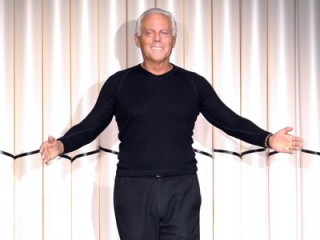
Giorgio Armani biography
Date of birth : 1934-07-11
Date of death : -
Birthplace : Piacenza, Italy
Nationality : Italian
Category : Famous Figures
Last modified : 2010-07-07
Credited as : Fashion designer, ,
2 votes so far
Armani was the first designer to ban models with a body mass index (BMI) under 18, after model Ana Carolina Reston starved herself to death due to anorexia nervosa.
The Armani Privé spring/summer 2007 fashion show was broadcast via MSN and Cingular cellular phones.
After LG teamed with Prada to introduce the LG Prada phone, Samsung joined Armani to design the Giorgio Armani phone.
Armani designed made-to-measure suits for Christian Bale's character Bruce Wayne in The Dark Knight. Advertisements featuring "Giorgio Armani for Bruce Wayne" were released in 2008 with pictures of Christian Bale wearing Armani suits. However, Bale later claimed in a GQ interview that the campaign was produced without his permission.
Giorgio Armani is a design colonialist responsible for the creation of an aesthetic in both menswear and womenswear that had a firm grip on international style in the 1980s. Renowned for his use of fabric and expertise in tailoring, he is a world leader in menswear design responsible for the wide-shouldered look for executive women. His pared-down unstructured silhouette moved away from the standard tailored look epitomizing menswear since the 19th century; by eliminating interfaces, linings, and shoulder pads, Armani restructured the jacket, creating a softly tailored look.
Although Armani produces entire ranges of these functional, adaptable, flexible items of clothing that seem almost throwaway in their simplicity, they are, in fact, luxurious designs made of high-quality cloth. His clothes, however, although expensive, have their own understated glamour and could never be described as ostentatious. Neither trend nor tradition, the Armani style draws a fine line between the two. Eschewing change for its own sake, he believes in quality rather than invention. His collections are redefinitions of a soft, unstructured style, playing with layers of texture and color but constantly renegotiating proportions. Elegant and understated, they have a timeless quality, a classicism often emphasized in nostalgic advertising campaigns by Italian photographer Aldo Fallai.
Born in Piacenza, Italy, in 1934, Armani's first taste of the fashion industry was with La Rinascente, a large Italian department store chain where in 1954 he worked on the window displays. He then transferred to the Office of Fashion and Style where he had an invaluable training in the use of fabrics and the importance of customer profiling and targeting. After seven years he left to design menswear for Nino Cerruti, and for a month worked in one of the firm's textile factories where he learned to appreciate fabric, the skills that went into its production, and the techniques of industrial tailoring.
In 1974 Armani launched his own label, which was to become incredibly successful—the biggest-selling line of European design in America. His first designs revolved around the refining of the male jacket, which he believed to be the most important invention in the history of dress, being both versatile and functional and suited to all social occasions. His idea was to instil the relaxation of sports clothing into its tailored lines. He later applied similar notions to womenswear, evolving a new manner of dress for women. He further developed a style for working women with an understated, almost androgynous chic.
In these years, Armani designs were very expensive, being made out of the most luxurious materials such as alpaca, cashmere, and suede. To expand his customer base and meet the increasing demands of a fashion conscious public for clothes with a designer label, he produced a cheaper womenswear range entitled Mani, made out of synthetics so advanced they could not be copied, together with the popular Emporio Armani range of sportswear. For men he produced definitive navy blazers, crumpled linen jackets, and leather separates, which he introduced in 1980, and oversized overcoats and raincoats. Impeccably tailored, with faltering cut, easy lines, and subtle textures, patterns, and colors, he introduced twists such as lowslung button placement on double-breasted suits for men and experimental blends of fabrics such as viscose with wool or linen with silk.
Like his contemporaries in the industry, Armani diversified into jeans, undergarments, neckwear, golf apparel, accessories, fragrances, and more recently, cosmetics. With more than a dozen clothing lines, the quality has not diminished, merely attracted a wider clientéle which in turn attracted the notice of luxury conglomerates LVMH and Gucci Group. Both approached Armani with acquisitive offers, but he refused. "Of course, I was flattered," he told Richard Heller of Forbes (12 November 2001), "But I decided to keep my independence." He is, indeed, one of a disappearing breed, without stockholders or backers to answer to—rather, he has increasingly bought his licensees and brought most Armani brand in-house.
If ever there was a doubt about how the world felt about Armani and his contributions to fashion, they were completley dispelled in November 2000 when the Guggenheim Museum threw a lavish gala to mark the opening of its Giorgio Armani retrospective in New York. Covering 25 years of Armani creativity and featuring 400 garments, the exhibition attracted a glittering crowd including Hollywood celebrities, athletes, and musicians. Giorgio Armani, now and forever, represents the finest in elegant, sophisticated style.
















